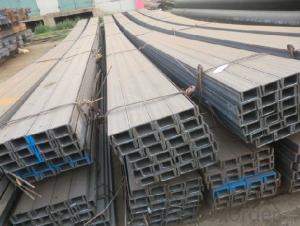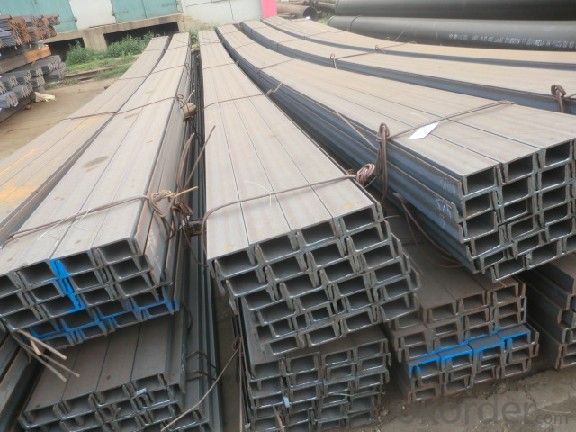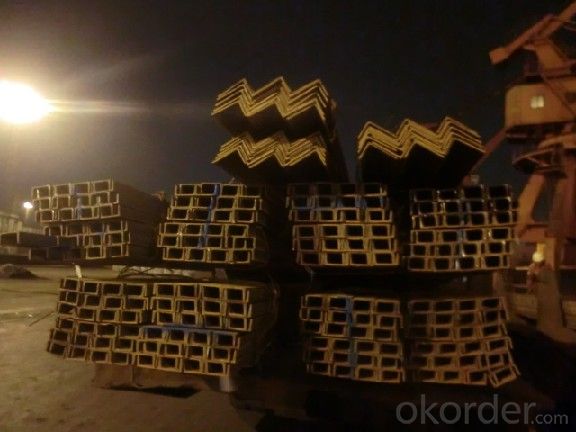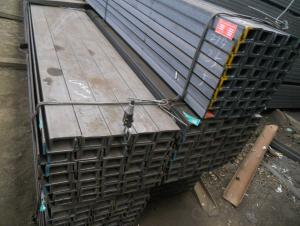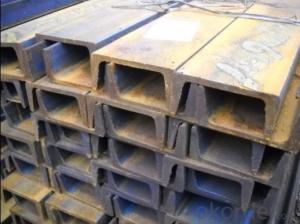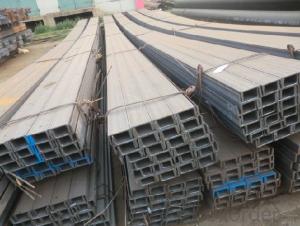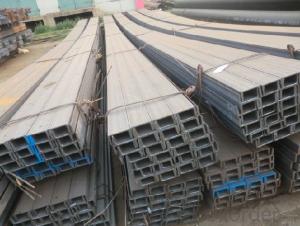hot channle and jis
- Loading Port:
- China Main Port
- Payment Terms:
- TT OR LC
- Min Order Qty:
- -
- Supply Capability:
- -
OKorder Service Pledge
OKorder Financial Service
You Might Also Like
Product Description:
Specifications of MS Channel:
1.We supply high quality MS Channel at reasonable price, including Chinese standard, Japanese standard and so on.
Standard | GB/JIS |
Material Grade | Q235,SS400 |
Technique: | Hot Rolled |
Sizes as per chinese standard: | 50*37*4.5mm - 300*89*11.5mm |
Sizes as per japanese standard: | 50*25*3mm – 200*80*7.5mm |
Length: | 6meter, 9meter, 12meter |
Note: 1.we are also competent to provide our customers other MS Channel based on other sizes according to customer’s requirements.
2. The length of our ms channel could be cut into other meters as per customer’s requirements. For example, the channel in 6meters could be cut into 5.8meters in order to be fit in the 20ft container.
2. The detailed sections of MS Channel as per GB standard.are shown in the table-1:
GB U CHANNEL | Standard | Sectional | Dimension |
| Mass: |
| (mm) | (mm) | (mm) | (mm) |
|
50X37 | 50 | 37 | 4.50 | 7.0 | 5.438 |
63X40 | 63 | 40 | 4.80 | 7.5 | 6.634 |
80x43 | 80 | 43 | 5.00 | 8.0 | 8.045 |
|
|
|
|
|
|
100x48 | 100 | 48 | 5.30 | 8.5 | 10.007 |
120x53 | 120 | 53 | 5.50 | 9.0 | 12.059 |
140x58 | 140 | 58 | 6.00 | 9.5 | 14.535 |
140x60 | 140 | 60 | 8.00 | 9.5 | 16.733 |
|
|
|
|
|
|
160x63 | 160 | 63 | 6.50 | 10.0 | 17.240 |
160x65 | 160 | 65 | 8.50 | 10.0 | 19.752 |
|
|
|
|
|
|
180x68 | 180 | 68 | 7.00 | 10.5 | 20.174 |
180x70 | 180 | 70 | 9.00 | 10.5 | 23.000 |
|
|
|
|
|
|
200x73 | 200 | 73 | 7.00 | 11.0 | 22.637 |
200x75 | 200 | 75 | 9.00 | 11.0 | 25.777 |
|
|
|
|
|
|
220x77 | 220 | 77 | 7.00 | 11.5 | 24.999 |
220x79 | 220 | 79 | 9.00 | 11.5 | 28.453 |
|
|
|
|
|
|
250x78 | 250 | 78 | 7.00 | 12.0 | 27.410 |
250x80 | 250 | 80 | 9.00 | 12.0 | 31.335 |
250x82 | 250 | 82 | 11.00 | 12.0 | 35.260 |
|
| |
|
|
|
280x82 | 280 | 82 | 7.50 | 12.5 | 31.427 |
280x84 | 280 | 84 | 9.50 | 12.5 | 35.823 |
280x86 | 280 | 86 | 11.50 | 12.5 | 40.219 |
|
|
|
|
|
|
300x85 | 300 | 85 | 7.50 | 13.5 | 34.463 |
300x87 | 300 | 87 | 9.50 | 13.5 | 39.173 |
300x89 | 300 | 89 | 11.50 | 13.5 | 43.883 |
Table-1
3. The chemical composition of HR Channel Steel according to Q235B is shown in Table-2.
Alloy No | Grade | Element(%) | ||||
C | Mn | S | P | Si | ||
Q235 | B | 0.12-0.20 | 0.3-0.7 | ≦0.045 | ≦0.045 | ≦0.3 |
Table-2
Note: we are able to present our customers relevant SGS test report for chemical composition of HR Channel Steel.
4. The mechanical property of HR Channel Steel according to Q235B is shown in Table-3-1 and Table-3-2
Alloy No | Grade | Yielding Strength Point(Mpa) | |||
Thickness(mm) | |||||
≦16 | >16-40 | >40-60 | >60-100 | ||
≧ | |||||
Q235 | B | 235 | 225 | 215 | 205 |
Table-3-1
Alloy No | Grade | Tensile Strength(Mpa) | Elongation After Fracture(%) | |||
| | Thickness(mm) | |||||
≦16 | >16-40 | >40-60 | >60-100 | |||
≧ | ||||||
G235 | B | 375-500 | 26 | 25 | 24 | 23 |
Table-3-2
Note: we are able to present our customers relevant SGS test report for mechanical property of MS Channel as customer’s request.
Applications of MS Channel:
The MS Channel can be applied to construction of warehouses, workshops, sport stadiums and car parks etc.The hot rolled channel steel belongs to carbon structural steel which is applied to in the field of construction and machinery.In details, the hot rolled channel steel is usually used for arch-itechtural structure, and they could be welded in order to support or hang a vari-ety of facilities. They are also usually used in combination with I beam. Generally,the hot rolled channel steel we supply must possess perfect welding property, riveting property and mechanical property and so on.
Package & Delivery of MS Channel:
1.The hot rolled channel steel will be packed in bundle with steel wire at each end of every bundle and color marking in order to help the customer to recognize his goods more easily at sight.
2. And the hot rolled channel steel could be loaded into 20ft or 40ft container, or by bulk cargo.If the weight of each bundle reaches more than 3.5 mt, the loading by break bulk cargo should be choosed.When the weight of each bundle reaches less than 3mt, the loading by container should be choosed.
3.As for the transportaion from mill to loading port, the truck will be usually used. And the maximum quantity for each truck is 40mt.
4.All in all, we could do in accordance with customer's request
- Q: When building a high building, in order to take scaffolding, the channel into the wall, support scaffolding, etc., after the completion of scaffolding dismantled, channel after taking out, although the hole will be filled well, but the building will not leak it? The building I bought a total of 32 layers, wherein the 9 layer, 17 layer, 25 layer into the channel, I bought 17 layers, the future will Water Leakage ah, good fear, a knowledgeable friend to help answer,...
- Holes filled well will not leakBut often it doesn't fill well
- Q: Do galvanized steel channels need anti rust treatment?
- Galvanized layer can play a good role in rust prevention, rust prevention can not be done anymore.
- Q: What are the different methods of painting steel channels?
- There are several methods of painting steel channels, including spray painting, brush painting, and electrostatic painting. Spray painting is a common method that involves using a spray gun to evenly coat the surface of the steel channel with paint. Brush painting involves manually applying paint with a brush, which allows for more control and precision in smaller areas. Electrostatic painting is a technique where the paint is positively charged and the steel channel is grounded, resulting in a highly efficient and even coat of paint.
- Q: What are the different methods of corrosion protection for steel channels?
- Steel channels can be protected from corrosion using various methods, each with its own advantages and suitability for different environments. Some commonly used methods are: 1. Galvanization, which involves applying a layer of zinc to the steel channel. The zinc acts as a sacrificial anode, corroding in place of the steel and protecting it from corrosion. Galvanization can be done through hot-dip or electro-galvanization. 2. Painting or Coating, where a protective paint or coating is applied to create a barrier between the steel and corrosive elements. Different types of paints and coatings, like epoxy or polyurethane, offer varying levels of corrosion resistance and durability. 3. Cathodic Protection, which connects the steel channel to a sacrificial anode, like zinc or aluminum, to create an electrical circuit. The anode corrodes instead of the steel, effectively protecting it. This method is particularly useful in submerged or buried environments. 4. Stainless Steel, which contains chromium that forms a passive oxide layer on the surface, providing excellent corrosion resistance. Stainless steel channels are commonly used in industries where corrosion resistance is crucial, such as marine or chemical industries. 5. Corrosion Inhibitors, chemicals that can be applied to slow down or inhibit the corrosion process. They form a protective film on the surface or alter the chemical environment around the steel. However, their effectiveness may vary depending on the application and environment. When selecting a corrosion protection method for steel channels, factors such as the operating environment, anticipated lifespan, and budget should be considered. Consulting with corrosion experts or engineers can help determine the most suitable and cost-effective method for a specific application.
- Q: How do steel channels contribute to building durability?
- Steel channels contribute to building durability in several ways. Firstly, steel channels provide structural support to the building. They are used to create the framework and framework support for floors, walls, and ceilings. This ensures that the building can withstand heavy loads and remain stable over time. Steel channels have high strength and rigidity, making them resistant to bending, warping, and twisting, which ultimately enhances the overall durability of the structure. Secondly, steel channels are highly resistant to corrosion. They are commonly made from galvanized or stainless steel, both of which have excellent resistance to rust and corrosion. This is particularly important in buildings that are exposed to moisture, such as coastal areas or places with high humidity. By using steel channels, the risk of structural damage caused by rust or corrosion is significantly reduced, leading to increased durability of the building. Furthermore, steel channels offer fire resistance. Steel is inherently non-combustible, meaning it does not contribute to the spread of fire. In the event of a fire, steel channels can help contain the flames and prevent them from spreading to other parts of the building. This fire-resistant property significantly improves the safety and durability of the structure. Lastly, steel channels are highly durable and require minimal maintenance. Unlike other building materials that may deteriorate over time, steel channels have a long lifespan and retain their strength and integrity for many years. They are not susceptible to rot, decay, or insect damage, which can be common issues with wood or other organic materials. This durability and low maintenance requirement make steel channels a cost-effective choice in the long run. In conclusion, steel channels contribute to building durability by providing structural support, corrosion resistance, fire resistance, and low maintenance requirements. Their strength, stability, and longevity make them an ideal choice for creating durable and long-lasting buildings.
- Q: How do steel channels perform in high-load applications?
- Steel channels perform exceptionally well in high-load applications. Due to their sturdy construction and high strength-to-weight ratio, they can effectively bear heavy loads without deformation or failure. Additionally, the structural integrity of steel channels ensures long-term durability, making them an ideal choice for high-load applications where reliability is crucial.
- Q: How are steel channels connected to other structural elements?
- Steel channels are typically connected to other structural elements through various methods such as welding, bolting, or using mechanical connectors. Welding is a common method used to connect steel channels to other structural elements. This involves melting the base metal of the channel and the adjacent structure, fusing them together to create a strong and permanent connection. Welding provides excellent strength and rigidity, making it suitable for heavy-duty applications. Bolting is another commonly used method to connect steel channels. It involves drilling holes through the flanges of the channel and the adjacent structure, and then inserting bolts through these holes to secure the connection. Bolting provides a flexible and reversible connection, allowing for easy disassembly or modification if needed. Mechanical connectors, such as beam clamps or channel connectors, can also be used to connect steel channels to other structural elements. These connectors often have a design that allows them to be easily attached to the channel and then secured to the adjacent structure using bolts or other fasteners. Mechanical connectors provide a convenient and efficient way to connect steel channels without the need for welding or complex fabrication. The method of connection used depends on various factors such as the structural design, load requirements, accessibility, and project specifications. Engineers and designers carefully consider these factors to determine the most suitable method of connecting steel channels to other structural elements, ensuring a secure and durable connection that meets the project's requirements.
- Q: Are steel channels suitable for agricultural buildings?
- Steel channels are indeed suitable for agricultural buildings, as they offer numerous advantages that make them an ideal choice for such structures. To begin with, the high strength and durability of steel channels are well-known. They have the ability to bear heavy loads and withstand harsh weather conditions, making them suitable for supporting the weight of agricultural equipment, storing feed, and enduring the elements. In addition, steel channels are resistant to pests commonly found in agricultural environments, such as termites and rodents. This makes them a more reliable and long-lasting option compared to other materials that may be prone to pest damage. Furthermore, steel channels are fire-resistant, which reduces the risk of damage or loss in the event of a fire outbreak. This is especially crucial for the safety of livestock and stored crops. Moreover, steel channels are highly versatile and can be easily customized to suit the specific requirements of agricultural buildings. They can be designed to accommodate various layouts and configurations, enabling efficient use of space and optimal functionality. Lastly, steel channels require minimal maintenance throughout their lifespan, resulting in reduced overall ownership costs for agricultural buildings. This is particularly advantageous in the agricultural sector, where time and resources are often limited. Considering these factors, it is evident that steel channels offer strength, durability, versatility, and cost-effectiveness, making them a suitable and advantageous choice for agricultural buildings.
- Q: How do steel channels contribute to the overall cost-effectiveness of a project?
- Steel channels contribute to the overall cost-effectiveness of a project in several ways. Firstly, steel channels are known for their durability and strength, which means they have a longer lifespan compared to other materials. This results in reduced maintenance and replacement costs over time, thus saving money in the long run. Additionally, steel channels are lightweight yet robust, making them easier and more cost-effective to transport and handle during construction. This can reduce labor and transportation costs, as well as the need for heavy machinery, ultimately contributing to overall cost savings. Moreover, steel channels are versatile and can be easily fabricated to meet specific project requirements. Their adaptability allows for efficient customization, eliminating wastage and reducing material costs. Furthermore, steel channels have excellent corrosion resistance properties, reducing the need for regular maintenance and extending their lifespan, thus providing additional cost savings. Furthermore, steel channels are often produced using recycled steel, which is not only environmentally friendly but also cost-effective. By utilizing recycled materials, the overall cost of production can be reduced, making steel channels a more affordable choice for construction projects. Lastly, steel channels offer a high strength-to-weight ratio, meaning fewer materials are needed to achieve the same structural integrity compared to other materials. This results in cost savings in terms of material procurement and construction time, as less material needs to be installed. In conclusion, steel channels contribute to the overall cost-effectiveness of a project by providing durability, lightweight characteristics, adaptability, corrosion resistance, and the potential for using recycled materials. By considering these factors, the use of steel channels in construction projects can lead to significant cost savings, making them a cost-effective choice for various applications.
- Q: What are the different methods for transporting and handling steel channels?
- Various methods exist for transporting and handling steel channels, which depend on the specific requirements and logistics of the situation. Some commonly employed methods include: 1. Utilizing cranes: Cranes equipped with hooks or lifting magnets can transport and elevate steel channels. This approach is particularly suitable for heavy steel channels or large-scale projects. 2. Implementing forklifts: Forklifts with specialized attachments can transport steel channels within a facility or construction site. This method is ideal for smaller and lighter steel channels, enabling precise movement and placement. 3. Employing conveyor systems: In manufacturing settings, conveyor systems can transport steel channels between different processes. This method enhances efficiency and reduces the need for manual handling. 4. Utilizing flatbed trucks: Steel channels can be loaded onto flatbed trucks for long-distance transportation. Straps or chains are used to secure the channels and prevent movement during transit. 5. Employing palletizing: Steel channels can be stacked and secured on pallets to facilitate handling and transportation. This method is commonly used when shipping smaller quantities of steel channels or storing them in a warehouse. 6. Utilizing rollers or skids: For short distances within a facility or construction site, steel channels can be moved along rollers or skids. This method allows for easy movement and positioning of the channels. 7. Opting for rail transportation: When transporting larger quantities or over longer distances, steel channels can be transported via rail. Specialized rail cars or containers are used to securely transport the channels. It is crucial to consider the size, weight, and fragility of the steel channels when determining the appropriate method for transportation and handling. Strict adherence to safety measures is necessary to prevent accidents, and specific equipment may be required depending on the chosen method.
Send your message to us
hot channle and jis
- Loading Port:
- China Main Port
- Payment Terms:
- TT OR LC
- Min Order Qty:
- -
- Supply Capability:
- -
OKorder Service Pledge
OKorder Financial Service
Similar products
Hot products
Hot Searches
Related keywords
